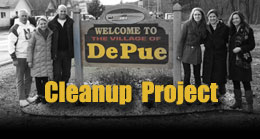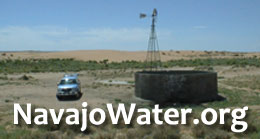Published: April 28, 2011
Kathy Helms of the Gallup Independent reported on Groundswell’s screening at the Department of Energy’s State of Environmental Justice Conference today. Read her article below:
‘Navajo Boy’ to be shown at environmental justice conference
April 28, 2011
By Kathy Helms
Dine Bureau
Gallup IndependentWINDOW ROCK – The award-winning film, “The Return of Navajo Boy” will be shown Thursday afternoon at the fifth annual State of Environmental Justice in America Conference in Washington.
Directed by Jeff Spitz of Chicago, the internationally acclaimed documentary that reunited a Navajo family and triggered a federal investigation into uranium contamination is a reminder of the legacy of Cold War uranium mining on the Navajo Nation.
The U.S. Environmental Protection Agency began cleanup March 30 of the Skyline Mine on Oljato Mesa in Monument Valley and radioactive waste in Elsie Begay’s back yard. Begay, who lost two children to radiation-related cancers, is featured in the Groundswell film which introduces audiences to Native American culture, environmental racism and one Navajo grandmother’s struggle for justice.
“Groundswell along with Elsie and other Navajo family members have worked tirelessly over the last 11 years for this outcome,” Spitz said. “The U.S. Department of Energy under the present administration is proud of this environmental justice story.”
DOE invited Groundswell to come to Washington to present the film and epilogue. Friday morning, on the second day of the conference, Spitz and Navajo participants will discuss how they use media, live events, advocacy and persistence to leverage change in public policy.
But while they celebrate the victory for Begay’s family, Spitz said, many other Navajo families are dealing with radioactive contamination and grief that simply cannot be contained.
One of the premier authorities on uranium issues in Navajo Indian Country, Perry Charley of Dine College’s Environmental Institute and a panelist on environmental health issues in Indian Country at the 2010 conference, had hoped to attend this year’s event. However, Spitz said, “His doctors will not allow the travel. He has cancer.”
Instead, Charley wrote a statement about the “real state of environmental justice in Navajo lands” for Spitz to share with the audience. “Sorry I can’t be there, but tell the crowd I wish them well. And the federal government has waited too long to fund many remedial projects, education and research studies,” he said.
Among the points Charley highlights is the Navajo Abandoned Mine Land Reclamation Department – which has so diligently monitored and performed remediation of abandoned uranium mines and mill sites on the Navajo Nation – is proposed to have its funding cut completely by the Obama administration, he said. “The program is desperately needed to perform continued surveillance and maintain reclaimed uranium mines and mills, some of which show signs of deterioration and exposing radioactive waste to nearby communities.”
Charley also expects a hard battle in Congress over passage of the Radiation Exposure Compensation Act Amendments of 2011, sponsored by U.S. Sen. Tom Udall of New Mexico and a bipartisan group of senators. “Many of our Navajo miners and families face challenges in getting compensation due to the heavy documentation requirement of the process. The federal government still does not understand the implications of traditional and cultural sensitivity,” he said.
And while there is now a five-year plan for cleanup of legacy waste, there is “no funding to perform many of the issues we face” from past Manhattan Engineer District and Atomic Energy Commission activities.
Charley said he personally has been sampling and conducting studies of the impacts to Navajo water sources. “We have a well with uranium concentration of 760 parts per billion,” many times above the 30 parts per billion Maximum Contaminant Level allowable under U.S. Environmental Protection Agency’s drinking water standards, “and another a few miles away with 200 parts per billion,” he said. “These communities have no alternate water source and the Navajo continue to use contaminated sources for their domestic needs.”
Companies who once mined Navajo lands for uranium need to be made to come back and clean up their mess, according to Charley. “We have tons of radioactive materials scattered throughout Navajo lands. Our water is contaminated and our air is contaminated. Homes are built with radioactive materials.
“We need studies to determine the impact to our children and their future. There has never been a true epidemiological study done on Navajo lands to determine the true extent of exposure. Small-scale studies and research point to contamination of every segment of our lives and society.”
Navajo also needs educational funds for programs such as the Uranium Education Program which he once directed and had to cease due to lack of funding. “We need to educate our people and our young ones to be part of this process, to be self-sustaining and to dictate our own future and destiny. We literally have dozens of mining companies at our reservation doors waiting for the moratorium on uranium mining and processing to be lifted on Navajo lands. The companies and federal entities that continue to disregard our tribal sovereignty laws and rights need to recognize these.”
Education and research studies need to continue, Charley said. “Even for some of us who have been involved in being part of these activities to try to correct the wrongs of the past, we are affected as well. I don’t know what my future holds, but I am fighting for my very survival,” he told Spitz. “Feel free to tell them this, especially the feds.”














